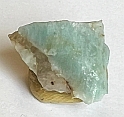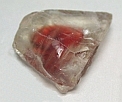Feldspar Visible Spectra (generally 350 - 2500 nm)
Pale yellow color in feldspar
is due to Fe3+ in the tetrahderal Si/Al site. This
color is often masked by the pervasive turbidity of common
feldspars. Smoky color, the result of radiation damage from the
decay of potassium-40, is also common but often masked.
Blue color in the
amazonite variety of potassium feldspar (and pale-blue albite as
well) is from the interaction of trace amounts of Pb2+
in the feldspar with ionizing radiation (again, the radiation
usually comes from the decay of potassium-40). Water molecules
also must be present in the structure for the coloration to
occur. Lead-containing feldspars with a higher degree of Al/Si
disorder (typically orthoclase) are green
where more the more
common ordered feldspars (microcline) become blue from
irradiation. Feldspars with intermediate ordering often show both
a green and a blue component in the spectrum.
Pale blue color also occurs in
plagioclase and occasionally, intense blue color
can be found as in the sample from the Behive #1 mine in the Boulder
Batholith, MT. Instances can even be found when colorless microcline
can be found in contact with pale blue albite such as the material from the White Queen Mine, Pala, CA
There are varieties of plagioclase feldspar colored
green and red
from copper ions and
colloidal copper found in southwestern Oregon..
-
Images of representative feldspars
Yellow, iron-containing feldspar
- GRR 146 spectrum;
Orthoclase, Itrongahy, Madagascar, pale
yellow crystal with Fe3+, 10 mm thick. Data Files: alpha; beta ; gamma. The spectrum is dominated by
absorption from Fe3+ in the tetrahedral site.
- GRR 289 spectrum;
Plagioclase, Lake County, Oregon, transparent, light amber crystal
 , plotted as 10.0
mm thick. This spectrum shows both absorption features from the Fe3+
in the tetrahedral silicon site in the 380 - 700 nm range and the features from Fe2+
in the calcium site in the 1000 - 2500 nm range. This sample contains
about 0.31 wt% Fe. Reference: Hofmeister and Rossman, Determination of
Fe2+ and Fe3+ concentrations in feldspar by
optical absorption and EPR spectroscopy. Physics and Chemistry of
Minerals 11:213-24 (1984)
, plotted as 10.0
mm thick. This spectrum shows both absorption features from the Fe3+
in the tetrahedral silicon site in the 380 - 700 nm range and the features from Fe2+
in the calcium site in the 1000 - 2500 nm range. This sample contains
about 0.31 wt% Fe. Reference: Hofmeister and Rossman, Determination of
Fe2+ and Fe3+ concentrations in feldspar by
optical absorption and EPR spectroscopy. Physics and Chemistry of
Minerals 11:213-24 (1984)
Blue to green, lead-containing potassium feldspar (amazonite variety)
- Amazonite CIT 13599 spectrum;
Microcline, Bahia, Brazil. An attractive blue
feldspar
 with ~300 ppm of Pb, plotted for 1 mm thick. This is
representative of the sky blue amazonite feldspars. There is almost no
absorption in the gamma direction. More details in Hofmeister &
Rossman (1985). Data Files: alpha; beta.
with ~300 ppm of Pb, plotted for 1 mm thick. This is
representative of the sky blue amazonite feldspars. There is almost no
absorption in the gamma direction. More details in Hofmeister &
Rossman (1985). Data Files: alpha; beta.
- Amazonite CIT 15020 spectrum; Microcline, turbid blue
perthite
 from Lake George, Colorado, USA, with ~700 ppm Pb plotted
for 0.5 mm thick. The steady rise in the baseline towards the
ultraviolet is due to scattering from the turbidity in the sample. Data
Files: alpha; beta; gamma.
from Lake George, Colorado, USA, with ~700 ppm Pb plotted
for 0.5 mm thick. The steady rise in the baseline towards the
ultraviolet is due to scattering from the turbidity in the sample. Data
Files: alpha; beta; gamma.
- Amazonite CIT 15065 spectrum; Microcline
in a coarse green perthite from Pearl, Colorado,
USA, with 0.8 wt% PbO, plotted for 0.5 mm thick.
- Amazonite CIT 13756 spectrum; Orthoclase, transparent green crystal with 1.8 wt% PbO from
Broken Hill, NSW, Australia, plotted for 0.5 mm thick. Data Files: alpha; beta; gamma.
- Amazonite GRR 2367 spectrum;
Orthoclase, transparent green
crystal
 from
Vietnam plotted as 1.0 cm thick. Data Files: alpha
20K; beta 20K; gamma 20K.
from
Vietnam plotted as 1.0 cm thick. Data Files: alpha
20K; beta 20K; gamma 20K.
- Amazonite GRR 2576 from Mt Ploskaya, Kola Penninsula, Russia. 1.113 mm. Data Files: ~alpha; ~beta
Blue, lead-containing plagioclase feldspars (spectra and pictures)
- GRR 580 spectrum;
Plagioclase (variety oligoclase), South Carolina,
 pale-blue with ~0.035 wt% PbO, plotted
for 10 mm thick. More details in Hofmeister & Rossman (1986). Data
Files: alpha beta; gamma.
pale-blue with ~0.035 wt% PbO, plotted
for 10 mm thick. More details in Hofmeister & Rossman (1986). Data
Files: alpha beta; gamma. - GRR 756 spectrum; Plagioclase (albite), Kenya. a pale blue crystal containing about 0.013 wt% PbO (curve a). When heated to 300 deg C for 25 minutes, it lost much of its color (curve b), but when the heated piece was irradiated with 26.6 Mrads of gamma rays, the blue color returned with even greater intensity (curve c). All spectra shown in the beta polarization plotted for 7.0 mm thickness.
- GRR 2954, Plagioclse (albite), Beehive #1 Mine, Delmoe Lake, Bourlder Batholith, MT, USA. A blue cleavlandite mass
 . No spectra at this time
. No spectra at this time - GRR 3825, Plagioclase (albite), Eibensteir an der Thaya, Lower Austria, Austria. A blue mass of albite feldspar
 . No spectra at this time.
. No spectra at this time. - GRR
3826, Plagioclase (albite), White Queen Mine, Pala, California. A pale
blue abite that grows in contact with a near-colorless microcline
 No spectra at this time.
No spectra at this time.
Grey feldspar (smoky variety)
- GRR 638 spectrum; Sanidine,
Eifel, Rhineland, Germany. Smoky
color megacryst
 .
Plottted as 5.0 mm thickness. The smoky color is the result of ionizing
radiation interacting with Al in the tetrahderal site.
.
Plottted as 5.0 mm thickness. The smoky color is the result of ionizing
radiation interacting with Al in the tetrahderal site.
Red and green, copper-containing feldspar (sunstone
variety)
- GRR 1615 spectrum;
Plagioclase, Ponderosa Mine, Oregon, transparent, deep red color from copper
 , 2.167 mm thick. Reference: Hofmeister and
Rossman, Exsolution of metallic copper from Lake County labradorite.
Geology 13, 644-647 (1985). Data Files: unpolarized
, 2.167 mm thick. Reference: Hofmeister and
Rossman, Exsolution of metallic copper from Lake County labradorite.
Geology 13, 644-647 (1985). Data Files: unpolarized - Labradorite, Rabbit Hills, Oregon. Red region, plotted as 2.0 mm thick.
- Labradorite, Rabbit Hills, Oregon. Green region, plotted as 1.0 mm thick
Pink albite
- GRR 3236 spectrum,
albite, Zagi Mountain, Pakistan, transparent, pink crystals
 , 3.83 mm thick, viewed on the (001)
face. The main absorption at about 538 nm is at a position appropriate for Mn3+. The spectrum also has two weak bands near 418 and 448 nm that arise from Fe3+ in the tetrahedral Si/Al site. Data Files: E ~ a = ~alpha; E ~ b = ~ gamma. This color fades in a matter of days when the sample is exposed to bright light.
, 3.83 mm thick, viewed on the (001)
face. The main absorption at about 538 nm is at a position appropriate for Mn3+. The spectrum also has two weak bands near 418 and 448 nm that arise from Fe3+ in the tetrahedral Si/Al site. Data Files: E ~ a = ~alpha; E ~ b = ~ gamma. This color fades in a matter of days when the sample is exposed to bright light.
Link to a collection of references to mostly color and visible spectroscopy of feldspars
 Back
to the list of minerals
Back
to the list of minerals
 Back
to the Index of Data Files
Back
to the Index of Data Files
 Back
to the
Mineral Spectroscopy home page
Back
to the
Mineral Spectroscopy home page
revised 5-Jul-2022 , plotted as 10.0
mm thick. This spectrum shows both absorption features from the Fe3+
in the tetrahedral silicon site in the 380 - 700 nm range and the features from Fe2+
in the calcium site in the 1000 - 2500 nm range. This sample contains
about 0.31 wt% Fe. Reference: Hofmeister and Rossman, Determination of
Fe2+ and Fe3+ concentrations in feldspar by
optical absorption and EPR spectroscopy. Physics and Chemistry of
Minerals 11:213-24 (1984)
, plotted as 10.0
mm thick. This spectrum shows both absorption features from the Fe3+
in the tetrahedral silicon site in the 380 - 700 nm range and the features from Fe2+
in the calcium site in the 1000 - 2500 nm range. This sample contains
about 0.31 wt% Fe. Reference: Hofmeister and Rossman, Determination of
Fe2+ and Fe3+ concentrations in feldspar by
optical absorption and EPR spectroscopy. Physics and Chemistry of
Minerals 11:213-24 (1984)








 , 3.83 mm thick, viewed on the (001)
face. The main absorption at about 538 nm is at a position appropriate for Mn3+. The spectrum also has two weak bands near 418 and 448 nm that arise from Fe3+ in the tetrahedral Si/Al site. Data Files:
, 3.83 mm thick, viewed on the (001)
face. The main absorption at about 538 nm is at a position appropriate for Mn3+. The spectrum also has two weak bands near 418 and 448 nm that arise from Fe3+ in the tetrahedral Si/Al site. Data Files: 